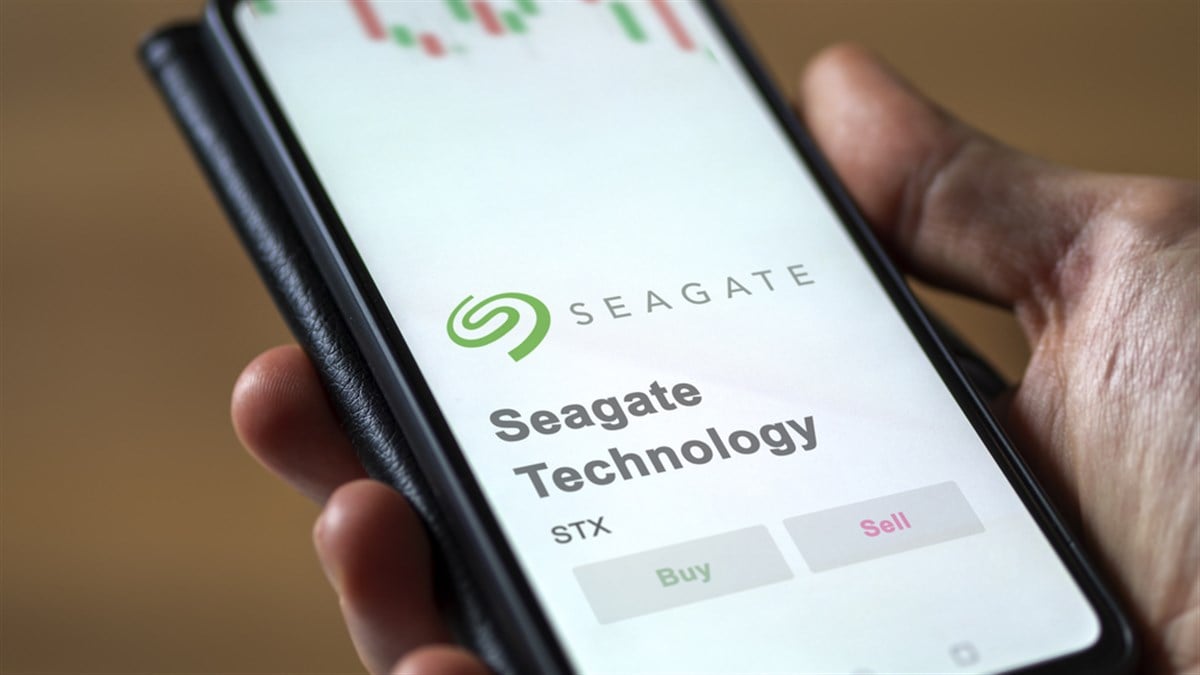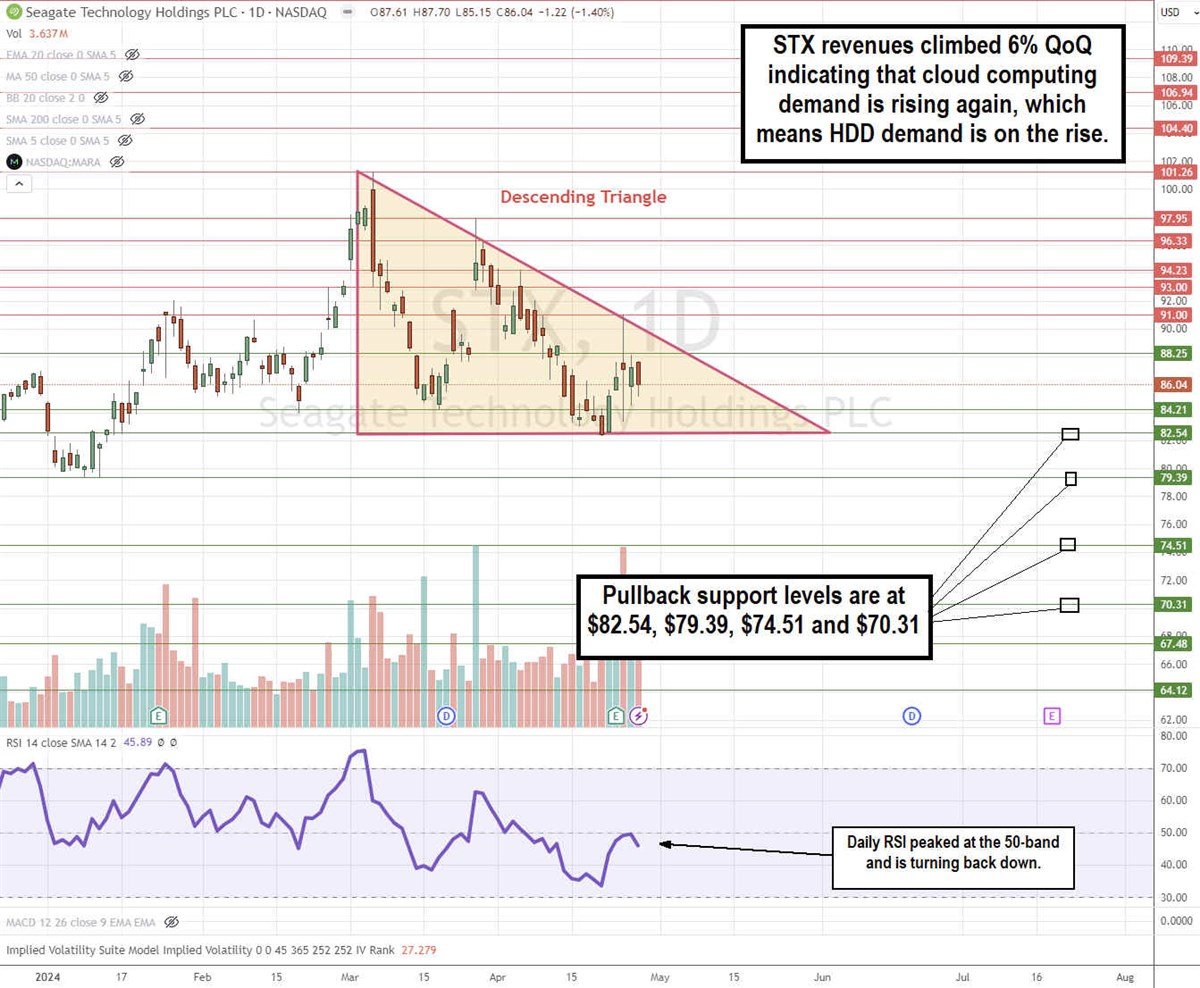 Data storage device manufacturer Seagate Technology Holdings plc (NASDAQ: STX) hasn't significantly benefitted from the artificial intelligence (AI) boom. Its computer and technology sector rival Western Digital Co. (NASDAQ: WDC) had a dramatic 2024 reversal of fortune as losses of 46 cents transformed into profits of 40 cents, and sagging revenues turned into a 23% YOY revenue spike. Seagate also saw a spike in its bottom line, not so much from AI but from the recovery of cloud computing demand. This impacts Seagate the most since 90% of cloud computing data centers still rely on hard disk drives (HDD) for data storage due to the larger capacity and cheaper costs compared to flash solid-state drives (SSD).
Data storage device manufacturer Seagate Technology Holdings plc (NASDAQ: STX) hasn't significantly benefitted from the artificial intelligence (AI) boom. Its computer and technology sector rival Western Digital Co. (NASDAQ: WDC) had a dramatic 2024 reversal of fortune as losses of 46 cents transformed into profits of 40 cents, and sagging revenues turned into a 23% YOY revenue spike. Seagate also saw a spike in its bottom line, not so much from AI but from the recovery of cloud computing demand. This impacts Seagate the most since 90% of cloud computing data centers still rely on hard disk drives (HDD) for data storage due to the larger capacity and cheaper costs compared to flash solid-state drives (SSD).
The Evolution of HDD Technology
HDD is considered a legacy technology. Even modern laptops and desktops retail computer systems are outfitted with SSDs due to their speed, reliability and non-moving parts. However, when large-scale data capacity is needed, HDDs still carry a heavy workload. Seagate has been a pioneer and innovator of HDD technology. While HDDs can't compete with the speed of NAND flash-based SSDs, they rule supreme when it comes to data capacity and cost. Seagate also produces SSDs, but they are a fraction of the HDDs.
Mozaic 3+ HDDs with HAMR Technology
Seagate has continued to push the capacity envelope with its HAMR technology, which is now powering its Mozaic line of HDDs. Mozaic 3+ drives can handle 3.2 petabytes of data over 6,000 hours with capacities exceeding 30 TBs and last more than seven years. Seagate's Exos 30 TB Mozaic 3+ drive for data centers nearly doubles the capacity in the same footprint. Seagate plans to ramp up capacity to 50 TBs.

Daily Descending Triangle Pattern
STX has a descending triangle breakout pattern on its daily candlestick chart. The descending trendline formed at $101.26, capping bounce attempts at lower highs, falling towards the lower flat-bottom trendline at $82.54, meeting at the apex point. The daily relative strength index (RSI) peaked its bounce attempt at the 50-band as it started to turn back down. Pullback support levels are at $82.54, $79.39, $74.52 and $70.31.
The Recovery Cycle Appears to be Underway
[content-module:CompanyOverview|NASDAQ:STX]Seagate reported fiscal Q3 2024 EPS of 33 cents, beating analyst estimates by 4 cents. Revenues fell 11% YoY to $1.66 billion versus $1.68 billion. However, sequential revenues rose 6% QoQ as non-GAAP EPS more than doubled sequentially. Non-HDD revenues were $178 million. Adjusted gross margins rose 250bps to 26.1%, which led to EBITDA margin expansion to 16.8%, up from 13.9% in the year-ago period. The recovery cycle is underway.
Seagate provided in-line fiscal Q4 2024 guidance with EPS of 50 cents to 90 cents versus 61 cents analyst estimates. Revenues are expected to be between $1.7 billion and $2 billion versus the consensus estimates of $1.85 billion.
HAMR Delays Should Result in Second-Half Surge
Seagate CEO Dave Mosely mentioned a temporary slowdown hiccup in recent weeks but is making progress towards its first large CSP customer qualification. Despite the hiccup, the company still expected to ship a few hundred thousand HAMR-based Mozaic drives in the June quarter. This should meet the remaining exabyte demand through other existing products. The company plans to ramp up HAMR products with its leading hyperscale client in the second half of the year. They will remain focused on broadening out the qualified customers of Mozaic products.
Mosely commented, ”We've laid out a Mozaic roadmap with a clear path to at least 50 terabyte drives that offers customers TCO and sustainability benefits, including lower power consumption and less required floor space on a per terabyte basis. We are scaling drive capacity through aerial density gains rather than adding heads and disks. As we execute on our product roadmap to 50 terabytes and beyond, we expect to incur minimal changes to our bill of material costs and maintain low capital intensity of between 4% and 6% of revenue.”
Analysts Remain Optimistic
Bank of America reiterated its Buy rating on Seagate with a price target of $110. Analyst Wamsi Mohan commented that despite the HAMR hiccup, they continue to see strength heading into fiscal Q4 2024. Mizuho reiterated their Buy rating with a $100 price target. Cantor Fitzgerald maintained a Neutral rating but raised its price target to $100 from $96.
Barclays was skeptical and maintained its Neutral rating and $80 price target. Analyst Tom O’Malley commented, "We think that the delay is more concerning than advertised and think it odd that after a failed qualification, regardless of reason, the timeline wouldn't lengthen more significantly.”
Seagate Technology analyst ratings and price targets are at MarketBeat.













